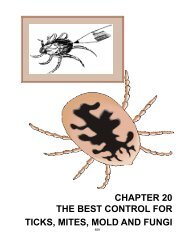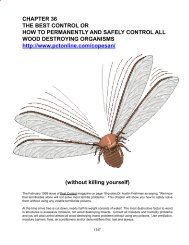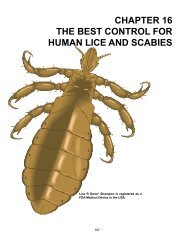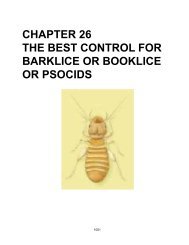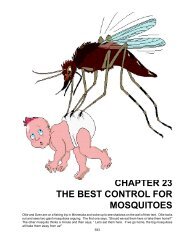ask the obvious question - Who is getting paid off there? Sodium borate or borax will completely denude aforest and kill any rodent or insect that eats it.Sodium Chloride - Common table salt will kill weeds, ants, fleas, termites and most other pests; it can besprayed directly on the pests or on the ground and wood, etc. <strong>The</strong> Dead Sea will always be dead because ofits (non-volatile) salt. See Natrum muriaticum.Sodium Chlorite - at 0.17% (0.0017) by weight, kills bacteria, mold, mildew and odors.Sodium Hypochlorite (in chlorine bleach) - if mixed with ammonia, releases toxic chloramine gas, causingasthma symptoms and even death.Sodium Laurel Sulfate - is on the EPA exempt list. It kills insects in 30+ seconds at a 1% rate and in 10 - 15seconds at a 3% rate all by itself. It kills/repels ticks, fleas and lice, and can be blended to help kill weeds.Sodium Silicate - Is the simplest form of glass and can be used as a fungicide.Soft Coal or Humates - are registered for foliar fertilizers. Apply them with an electrical charge and they willnot only cover all of the plant’s surfaces, they will suffocate any insect that is in the area at the time.Soft Drink Bottles - have been set in mole holes with the top left above ground to make a “whistle” as the breezepasses over the mouth, sending vibrations through the mole’s chamber. Use them as wasp, slug, roach traps, etc.Soil Amendments - An agricultural IPM technique to help reduce the need for pesticides.Soil Improvement or Fertility - Improving the soil produces vigorous plants with increased resistance to pestsand diseases. <strong>The</strong> less fertility in the soil, the more insect pests.Soil Quality - <strong>The</strong> first control for all plants is to improve the soil quality — organically!Soil Sterilization - Try a combination of brassicas tilled into the soil and then cover the freshly tilled soil withclear polyethylene plastic to trap solar radiation and heat the soil. You can also pasteurize soil with applicationsof hot water into the soil to a depth of 12” and using a rotovator to distribute the heat through the top foot ofsoil - this procedure not only manages pests but irrigates the field. Cover crops can be used to reduce soilpathogens (mainly nematodes), and to provide organic matter that will lead to improved yields (Peacock 1995).You can also kill weeds, nematodes and many insect pests when you cover the soil for several days in the sunwith black polyethylene plastic.Soil Tests - Use a soil sampler and conduct proper soil tests before you fertilize. Use organic fertilizers.Soil <strong>The</strong>rmometer - Use this to test soil to see when it is best to plant and/or to release nematodes.Solanine - is a steroidal glycoalkaloid (C 45H 73NO 15) naturally found in nightshade plants including the green inpotatoes; it is very similar to malathion. On hydrolysis it yields solanidine and 3 sugars. Its aglycone portion isconsidered most toxic; it is a naturally occurring insecticide poison - use only with great caution.Solar Treatment - During warm summer days insects, e.g., bed bugs, can be solarized outdoors to kill them all.Solvents - quickly kill insect and arachnid pests but, if they are volatile, they can also harm people, pets and plants.Soot - Old soot and agricultural lime, which has a strong, repulsive smell, can be placed in containers set onthe ground to keep flea beetles from the crops.Sound or Sound Waves - can be used to repel pests. When sounds 50,000 cycles per minute were broadcastover a corn field, the number of cornborer moths infesting the crop was cut in half. Ultra sound vibrations 200,000per second passed through water suffocated mosquito larvae by shattering their windpipes.458
Sour Milk - sprays will loosen scale on small trees and plants so you can wash them off with water later.Sour Sop (Annona muricata) - Powdered seeds are toxic to armyworms and pea aphids.Southernwood - will repel ants (and the aphids they carry), cabbage moths and fruit tree moths.Soybean Oil - Kills mites. Kills beetles and other insect pests. Repels mosquitoes.Spanish Dagger (Yucca shidigera) - Powdered leaves are toxic to melonworms, bean leafrollers, celery leaftiersand other insects.Spearmint - will repel ants and mice.Sponges - Compressed sponge pieces with an attractant will kill any rodent that eats them. Caution: this mayalso harm other mammals and kills slowly, so use only when safe and legal.Spot Treatments with Pesticide Poisons - <strong>The</strong> only suggested (non-volatile) pesticides we “recommend” beused as a last resort - usually we will not apply even least-toxic pesticides unless it has an LD 50value of over5,000 and does not volatilize! While I know it is against the federal law to compare a pesticide’s LD 50value withany food product, I do believe that you as a reader should be aware some materials we daily ingest do have anLD 50value; for example, table salt has an LD 50value 3,500. <strong>The</strong> only reason I mention this is that just becausea product has an LD 50value for its active ingredient does not in and of itself indicate the danger or risk you areass/u/ming when you use that product:Registered Pesticide Poison Note: It is O.K. to say a generic (unregistered) product will control pests - but, ifyou say your product controls pests - it “magically” becomes an unregistered pesticide! When pepper spray usedto discourage muggers (people) was used to successfully ward off bear attacks - EPA classified it as a pesticidepoison. Apparently unregistered products or Pestisafes ® that control pests better and safer than registeredpoisons are an embarrassment not only to the poison “industry” but also to the “regulators”. Use registeredtoxins only as a last resort and, by law, only according to labeled directions! Never use the volatile ones!Intelligent Pest Management ® (IPM), prioritizes any treatment methods by always using the least hazardousand least intrusive means first, in order to effectively eliminate pests indoors, at the lowest possible health risk tothe customer and the applicator. It is always best to error on the side of safety rather than on the side of control.Before you agree on even a spot treatment; thoroughly review the pesticide and application method with thecustomer to be sure he or she understands the entire process. Be forthright about any conditions or problemsthat might result due to a treatment, including lingering odors. Always inquire about heart or respiratory problems,allergies, pregnancy and other medical conditions and/or medications that may prohibit treatment.When in doubt, provide the homeowners or other occupants with the current pesticide label and material safetydata sheet (MSDS) and let them decide. You should suggest that they consult their physician if they have medicalquestions relating to the treatment.SAFETY FIRST. Safety guidelines should always permeate every aspect of pest control - especially anypesticide (poison) applications. You should always inspect and troubleshoot before each job in order to protectyourself and your customers. Whether the treatment is inside or outside, all possible alternative Intelligent PestManagement ® techniques should always be attempted before making any pesticide poison application.Spray Bottle Cures - Non-toxic “pesticide” sprays that can be made from ingredients readily available in thehome. See also old fashioned spray mixes under Ants and/or Roaches in <strong>The</strong> <strong>Best</strong> <strong>Control</strong> © and also in thischapter, e.g., apple cider vinegar, castor oil, buttermilk, eggs, hydrogen peroxide, rhubarb, stinging nettles, sugar,urea, vinegar and wormwood. <strong>The</strong> Author prefers to call them Pestisafes ® .1. All-purpose - Take an empty spray bottle and fill about 3/4 of the way with water, then add a fewdrops of Ivory liquid soap, some hot peppers or hot pepper sauce and some garlic. This works well,but needs to be reapplied after every storm and/or every couple of weeks.459
- Page 1:
CHAPTER 11SAFE AND FAR MOREEFFECTIV
- Page 4 and 5:
pesticide poisons do - to them the
- Page 6 and 7:
American Beautyberry (Callicarpa am
- Page 8 and 9:
packets in 4 days or less. Aspartam
- Page 10 and 11:
Baking Soda - Baking soda or sodium
- Page 13 and 14:
Bioderivatives - are substances whi
- Page 15 and 16:
Bird feeders - will attract more th
- Page 17 and 18:
an abrasive action on the insect wh
- Page 19 and 20:
pathogens - volatiles produced duri
- Page 21 and 22:
ground, grain and stored product ap
- Page 23 and 24:
epels many insects, including flies
- Page 25 and 26:
een used medically since at least t
- Page 27 and 28:
Collateral Damage - When you spray
- Page 29 and 30:
Cottonseed Meal - is a source of ni
- Page 31 and 32:
Desiccants - Hot air, dehumidifiers
- Page 33 and 34:
Dogs - have been trained to sniff o
- Page 35 and 36:
elderberry leaves to protect them f
- Page 37 and 38:
controls pests and acts as a deodor
- Page 39 and 40:
contamination that no one can hones
- Page 41 and 42:
Chlorphyll Graphite Parrafin wax Wa
- Page 43 and 44:
Film Capsule - The plastic capsule
- Page 45 and 46:
Repel roaches with bay leaves and e
- Page 47 and 48:
person in your house, but you’ll
- Page 49 and 50:
slender sickle-shaped jaws. They ap
- Page 51 and 52:
epellent that contains only natural
- Page 53 and 54:
infusion of pignut leaves, rubbed o
- Page 55 and 56:
Human Hair - cut in small pieces wi
- Page 57 and 58: Insect Diseases - In 1836, Agostino
- Page 59 and 60: Irrigation Management - Improper ir
- Page 61 and 62: lack cutworms.Laxatives - Chocolate
- Page 63 and 64: we die. Check out magnesium in Chap
- Page 65 and 66: Milk Thistle - is a proven detoxifi
- Page 67 and 68: Moon Flower (Datura ioxia) - Do not
- Page 69 and 70: Spotted knapweed begins producing c
- Page 71 and 72: Nothing - Doing nothing is a choice
- Page 73 and 74: fertilizers and sprays will normall
- Page 75 and 76: added to enzyme cleaners or when us
- Page 77 and 78: yellow to yellow crystalline solid
- Page 79 and 80: Aureolaria virginica (L.) Pennell.
- Page 81 and 82: Clematis vitalba L. (Honduras fish
- Page 83 and 84: Euphorbia bicolor Engelm. and Gray.
- Page 85 and 86: Justicia adhatoda L. (Adhatoda vasi
- Page 87 and 88: Momordica charantis L. (Balsam-pear
- Page 89 and 90: Piper nigrum L. (Black pepper).Stro
- Page 91 and 92: Sesamum indicum L. (S. orientale L.
- Page 93 and 94: Xanthorrhoea hastilis R. Br. (Black
- Page 95 and 96: Pomander - Repel moths and other in
- Page 97 and 98: y Safe Solutions at 1-888-443-8738
- Page 99 and 100: ight red and cover them with petrol
- Page 101 and 102: a wide variety of antioxidants call
- Page 103 and 104: Sawdust - Sawdust can be treated wi
- Page 105 and 106: lit charcoal in the tunnels would a
- Page 107: Active IngredientGeneric Name Trade
- Page 111 and 112: Stay Calm - Take a deep breath amd
- Page 113 and 114: to make the mix about the consisten
- Page 115 and 116: pesticides have never controlled or
- Page 117: Temperature - Increase or lower tem
- Page 120 and 121: in colder climates. The most fragra
- Page 122 and 123: and/or dehumidifiers, plumbing and
- Page 124 and 125: odents, scorpions, etc. to your bai
- Page 126 and 127: Oregano also contains four anti-ast
- Page 128 and 129: like colds, and headaches and spend
- Page 130 and 131: then estimated human population. Gi
- Page 132 and 133: “The choice, after all, is ours t
- Page 134: 484



